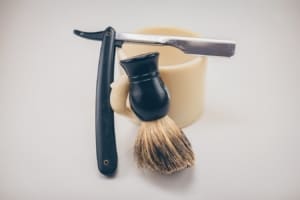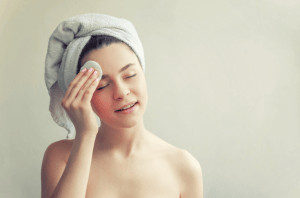What Is Dermaplaning? Benefits Of Dermaplaning & More!

Before making the appointment that will miraculously “shave” years off of your face, it would be wise to be sure you have all the information so that you know what to expect. Ever heard of dermaplaning? A dermaplane facial can enhance the skin, but the truth is that it’s not really so miraculous. In fact, let me break it down and dispel some of the misconceptions and explain some of the benefits as well as what to be careful with. Your decision to have this procedure should be based on having the facts to make a more informed choice. And if you choose a DIY route as opposed to going to a professional, better have as much information as possible.
The first place to start is by identifying what you hope to achieve. Is the primary goal to remove unwanted hair? Or possibly smooth skin removing fine lines, wrinkles, and scars? But before we get carried away, let’s take a closer look at what exactly is dermaplaning?
What Is Dermaplaning? What Does Dermaplaning Do?

Woman with smooth skin.
When performed by a highly trained dermatologist or licensed esthetician, a dermaplane facial can indeed give your face a cleaner, younger, and clearer appearance. This is a non-invasive procedure with no pain involved. A dermaplane facial is basically a very thorough manual exfoliation, removing the thinnest layer of skin and taking with it dead skin cells, fine vellus hair, and trapped dirt and oil. It reduces the appearance of fine lines and wrinkles as well as some acne scars leaving your face touchably smooth.
But you should avoid the temptation to touch your face after treatment, as you’ll only spread the impurities that are on your hands to your more exposed face.
Dermaplaning Vs Shaving Explained
Needing the right tools for the job is so much more than just a cliche when it comes to hair removal. It’s important that the appropriate tool is used and it’s also important that those using the tools know how to use them properly. If the only goal is to remove the fine vellus hair from your face, you could simply use a shaver, just don’t expect the same results.
Regular razors often have multiple blades, boasting that if one blade misses the hair another blade will get it. That being said, by using a thin dermaplaning blade or 10-gauge scalpel you can achieve your goal much more effectively since you are exfoliating more evenly and taking the outermost layer of skin as you go.
At the end of the day, the two methods are very similar for hair removal, if that is your primary goal. Dermaplaning is more precise than shaving, but with both methods, you will have regrowth.
Benefits Of Dermaplaning Explained
There are some real and visible benefits to dermaplaning for acne scars, but it’s important to know that this is for the scars left behind and not for active acne, eczema, or rosacea. Let’s take a closer look at some dermaplaning pros and cons. A major pro is that it can help to reduce clogged pores thus minimizing the occurrence of pimples.
Another key benefit of dermaplaning is its anti-aging effect. When you slough off layers of dead skin you’re left with younger-looking, glowing skin. It can reduce those fine lines, hyperpigmentation, and improves your skin’s texture. This allows for a smoother base for makeup to be applied more evenly. For those whose vellus hair is too sensitive to use a depilatory, dermaplaning can be the best alternative. Adding this procedure to your beauty routine is cost-effective, easy, and painless.
However, a con is that it leaves the skin exposed to the harsh environmental elements. Although infection is rare there is still a risk. Another con that shouldn’t be overlooked is that many people spend more time and effort on the symptom of hair growth rather than the cause. This means that they may potentially miss signals of health issues.
DIY Dermaplaning: How To Dermaplane At Home

Single blade razor.
While dermaplaning at home can be done at a very low cost, I’m not convinced that it should be. But for those that insist, here’s how it can be achieved as safely and effectively as possible.
You’ll need to first invest in a good quality (single) blade or scalpel, and have a good grasp on the procedure.
To begin with, it’s always important to work on a clean surface. So, cleanse your face with a mild and gentle cleanser and pat dry. With one hand you’ll want to hold a portion of your skin relatively taut and with the other hand take the blade at about a 45-degree angle. In gentle strokes, move the blade in the opposite direction of the hair’s growth for maximum removal, barber style. You want to keep the blade as parallel to the skin as possible. Use smooth and steady strokes to avoid nicks.
Care should be taken so you don’t over-plane. Watch for any active acne or other inflammation and steer clear of that area.
What You Need To Know About Dermaplaning Aftercare
Now that you’ve completed your treatment, you must keep in mind that you’ve just caused trauma to your skin. This means that it’s important to make sure to follow up with appropriate care after your dermaplaning treatment. If you have gotten any nicks, pause the treatment and tend to the nick. Once the bleeding has subsided and the area is clean, apply a little Neosporin or Aquaphor to the cut. Make sure not to dermaplane that spot until totally healed.
You’ll need to avoid additional trauma to your skin for 24 hours. This means avoiding harsh products on the area, including facial scrubs, sun exposure, and excessive sweating. When you wash your face, just use your fingertips rather than a washcloth, and pat dry softly with a clean towel.
As for moisturizing, many people find products containing hyaluronic acid, vitamin C, and retinol are particularly effective for your post-dermaplaning treatment.
Dermaplaning Before And After

Wash your face thoroughly before dermaplaning.
Of course, there could be some breakout after dermaplaning and that is perfectly normal since you’ve disturbed the skin. You have to remember that whatever was just beneath the layer of skin you’ve sloughed off is now at the surface.
For the best dermaplaning results, you’ll want to begin this process long before any special event. This allows time for your skin to heal and adjust. Many people claim to have better dermaplaning results by washing their face prior to the procedure with a mild exfoliant. The theory behind that is that there is less planing needed. Remember that you do not want to perform this procedure on skin that is already traumatized, so keep it mild.
How Long Does Dermaplaning Last? How Often Should You Dermaplane?
Generally, in the beginning, you can safely repeat a dermaplaning treatment in 3-4 weeks, making certain that the skin is completely healed. After some treatments, when you get used to the treatments, you can plane in a week to 10 days. Most people will equate dermaplaning as just glorified shaving and warn you not to shave your face since it will make you grow more hair and it will be thicker and darker.
Does dermaplaning make hair grow back thicker or darker? Absolutely not – it’s scientifically impossible. But it’s easy to make such a mistake in thinking that. Simply put, after a dermaplaning treatment, you’ve removed a layer of dead skin and vellus hair. This leaves your skin much brighter so that when there is regrowth, it seems darker and thicker. Since you’ve blunt-cut the hair it may feel more coarse but as it grows, it is the same texture as before the treatment.
Best Dermaplaning Tool: Dermaplaning Blades Breakdown
There are single barber-like blades and kits available for your at home use. You’ll want to be sure to choose one with a built-in blade guard for your protection. Most blades will be made of stainless steel, so there is no fear of rust. The most important point when choosing your dermaplaning tool is really what not to choose.
It’s vital to make sure that whatever tool you choose, it must be clean and sterile. It will never be a good idea to use the same disposable razor you just used on your legs. You’ll see that there are tools on the market that are labeled as eyebrow razors. You can also use these to safely and effectively dermaplane your face.
Conclusion
If you are looking for an inexpensive method to remove unwanted hair from your face while exfoliating, sloughing off impurities, dead skin, and revealing a glowing renewed look, dermaplaning may be something to try. You’ll want to use the appropriate tool to achieve optimum results. Also, be mindful of your skin type before going ahead. It’s important to remember that if you have active acne, eczema, or other skin irritation including sunburn, you should not plane the area.
While this can be done by a professional in a clean environment, results can also be achieved at home with quite a time and financial savings.
There are plenty of misconceptions about this method of hair removal, one in particular being that hair will regrow thicker and heavier. Dermaplaning will never make more hair grow, nor will it make the regrowth heavier or more course. The regrowth will simply have the same texture as before the treatment. And remember that a steady hand and a clean tool are important to avoid nicks.


